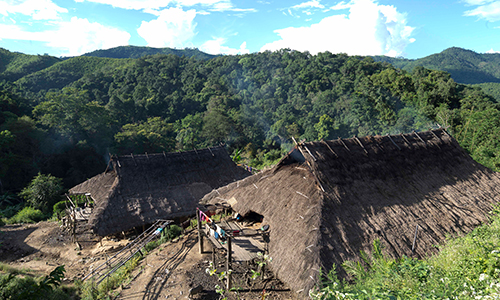
Faculty of Architecture | คณะสถาปัตยกรรมศาสตร์

M.Arch (Built Environment) | 2 Years program


M.Arch (Built Environment) | 2 Years program
หลักสูตรสถาปัตยกรรมศาสตรมหาบัณฑิต สาขาสิ่งแวดล้อมสรรค์สร้าง สร้างขึ้นเพื่อผลิตบุคลากรที่มีองค์ความรู้ด้านการสร้างสรรค์สิ่งแวดล้อมในหลายระดับและมีทักษะการวิจัยเชิงบูรณาการองค์ความรู้จากศาสตร์ด้านอื่น ๆ ที่เกี่ยวข้อง โดยผสานกับเครื่องมือและทักษะในการออกแบบ วางแผน และการจัดการเชิงพื้นที่เป็นสำคัญโดยเน้นการทำความเข้าใจบนพื้นฐานของประเด็นปัญหาสังคม วัฒนธรม วิถีชีวิต หรือสถานการณ์จริงในปัจจุบัน ที่เกิดขึ้นจากพลวัตของสังคมและสิ่งแวดล้อมที่กำลังเปลี่ยนแปลง มีจิตสำนึกรับผิดชอบต่อความเชื่อมโยงระหว่างสิ่งแวดล้อมที่มนุษย์สร้างขึ้นสามารถเชื่อมร้อยองค์ความรู้ด้านสิ่งแวดล้อมสรรค์สร้าง ทั้งในเชิงวิจัยและเชิการปฏิบัติวิชาชีพทางสถาปัตยกรรมนำไปสู่ความเข้าใจในศาสตร์ที่หลากหลายและสามารถนำมาปรับใช้และต่อยอดในการสร้างสรรค์การจัดการและรักษาสภาพแวดล้อมอย่างเท่าทันสถานการณ์และยั่งยืน จุดเน้นของหลักสูตรสถาปัตยกรรมศาสตรมหาบัณฑิต (สิ่งแวดล้อมสรรค์สร้าง) มีดังนี้
สำเร็จการศึกษาในระดับปริญญาตรีหรือเทียบเท่า สาขาวิชาสถาปัตยกรรม สถาปัตยกรรมภายในหรือมัณฑนศิลป์ ภูมิสถาปัตยกรรม สถาปัตยกรรมผังเมือง การออกแบบอุตสาหกรรม รวมทั้งสาขาวิชาอื่น ๆ และมีผลการสอบภาษาอังกฤษได้ตามเกณฑที่มหาวิทยาลัยกำหนด สำหรับระเบียบปฏิบัติอื่น ๆ เป็นไปตามที่มหาวิทยาลัยกำหนด Individuals who have obtained a bachelor's degree or its equivalent in fields such as Architecture, Interior Architecture, Decorative Arts, Landscape Architecture, Urban Architecture, Industrial Design, or related disciplines are eligible to apply. Additionally, applicants must meet the English proficiency requirements established by the university. Further details regarding regulations and procedures can be found in the university's guidelines.
หลักการคัดเลือกผู้สมัครเข้าศึกษา ใช้วิธีการสอบสัมภาษณ์โดยพิจารณาจากประวัติการศึกษา ความรู้ ประสบการณ์ ความสามารถในการออกแบบ ศักยภาพการดำเนินงานวิจัย ทัศนคติ ตลอดจนเวลาที่จะให้ในการศึกษา ร่วมกับคุณสมบัติอื่น ๆ จากใบสมัครและหลักฐานประกอบการสมัครThe selection process for prospective students is guided by principles that prioritize an interview-based assessment. This method evaluates candidates' educational background, expertise, practical experience, and proficiency in design. Additionally, considerations are given to applicants' research aptitude, commitment to learning, and ability to manage time effectively. The evaluation encompasses various qualifications outlined in the application, supplemented by supporting evidence provided by the applicants.

This module focuses on the intersection of architecture and human health, exploring design strategies that promote physical, mental, and emotional well-being. Topics include biophilic design, healthy building materials, access to natural light and ventilation, and the creation of spaces conducive to physical activity and relaxation.

This module delves into the relationship between architecture and the natural environment, addressing issues such as sustainability, resource management, climate change adaptation, and ecological design principles. Students learn to integrate environmental considerations into the design process to create buildings and urban spaces that minimize environmental impact.

This module examines the complexities of urban environments and the role of architecture in shaping them. Students explore concepts such as urban morphology, placemaking, community engagement, and urban regeneration. They learn how to design inclusive, vibrant, and sustainable urban spaces that enhance quality of life for residents.

This module explores the preservation and adaptive reuse of historic buildings and cultural heritage sites. Students learn about heritage conservation principles, restoration techniques, heritage legislation, and the cultural significance of architectural heritage. They develop skills in documenting, assessing, and conserving historic structures for future generations.

This module explores traditional building techniques, indigenous architecture, and the cultural significance of built environments. Students study vernacular architecture from different regions and cultures, analyzing its adaptation to local climate, materials, and cultural practices. They learn to draw inspiration from vernacular architecture while addressing contemporary design challenges.

This module emphasizes participatory design approaches that involve end-users in the design process. Students learn to conduct user research, engage stakeholders, and facilitate collaborative design workshops. They develop empathy-driven design solutions that respond to the needs, preferences, and aspirations of diverse user groups, fostering inclusive and socially responsive architecture.
The application period is ongoing throughout the year via the university system. Please visit https://www.grad.ku.ac.th/en/ for more detatil.
Spring (December – March)Autumn (July – October)
The USD course fee mentioned here is an approximate amount in THB, this may vary depending on the exchange rate at the time of payment.
each semester

To apply for admission, applicants are required to submit the application form and verify details regarding the schedule and application process for the available programs, eligibility criteria, examination dates, times, and venues via the university system. You can access the necessary information and forms at university's website by clicking link below; Apply here
Vacancies
Course Load (credits)
years
IMPORTANT: The course will be given in Thai and English. English proficiency certification is not mandatory upon enrollment, but we recommend a minimum of B-level CEFR (or an equivalent) for effective communication and understanding of all courses. NOTE: For additional details, please refer to the university's website or reach out to the admissions office.